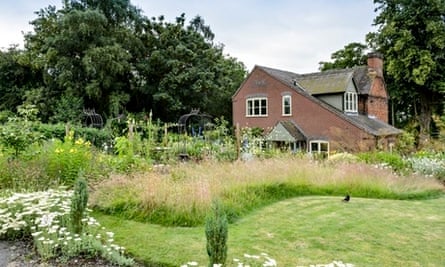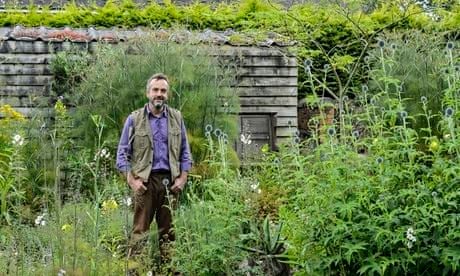I can remember the blast of heat and resinous scent hitting me at the top of the aircraft steps as if it was yesterday. In fact, it was 1978 and a 14-year-old boy with a head full of Gerald Durrell's adventures was on his first holiday abroad, on Corfu. As a professional gardener, it seems that experience of a Mediterranean summer has permeated my choices ever since.
Four years ago, I began making my first proper garden at home. I'd moved a lot over the years, mainly renting, and my gardening had largely been for others, though of course I had collected some plants. Each move necessitated an audit and some goodbyes, and it seemed only right that the faithful specimens, in it for the long haul, were given precedence in the new garden.
The trouble was they had a distinctly exotic air and the garden is in rural Staffordshire. The oldest was a tender Hibiscus rosa-sinensis 'Dorothy Brady' grown from a cutting I took at Cannington College during my first formal training in horticulture. Each year it had valiantly recovered from an underlit winter indoors to display its semi-double trumpet blooms, in a rare pale red, through summer and autumn. It would still need heated winter digs and a pot, but how could I create a context to suit it in summer?

The new plot surrounded a Victorian cottage that had been doubled in size in the 1980s to house proportions. This, I felt, allowed a garden style beyond the simply "cottagey". The 35m x 20m site sloped gently to the south. It was all lawn except where the previous owner had stripped away the topsoil next to the garage and replaced it with rubble as foundation for a parking space. While I deliberated about paths and beds, we had a large hole dug for a gas tank. This revealed that below the two-foot layer of slightly acidic loam it was pure sand.

A sunny, free-draining site felt like permission to indulge my taste for all things Mediterranean. I started with the depleted soil next to the garage. I added a 50:50 mix of grit and topsoil over the hardcore, then used a pile of Cotswold chippings from the car park project as a mulch that would raise the pH and suit many Mediterranean subjects. In my mind, I had the phrygana or dwarf scrub vegetation, often grey-leaved and aromatic, I had seen when gardening on the Greek island of Spetses.
In my new garden, a "hillside" walk would lead via a thyme path and a vine-clad arch to a central seating area, surrounded by dwarf lavender. This scheme now bleeds into more traditional planting with visual links made using the same restricted colour palette and repeating plant forms – upright grasses, verbascums and iris, and rounded evergreens.
A chusan palm, an itinerant now firmly planted, dominates the front garden. The Victorians were great exotic enthusiasts, so it seems to endorse rather than contradict the age of the cottage. The supporting cast is lusher than the back garden, with hot colours and bright green foliage more akin to a Riviera garden than arid Greek terrain.

It is a surprisingly practical design solution. It houses my original plant collection and, with my work in London leading to long absences, the tough, drought-tolerant species fend well for themselves. But it also harbours something less tangible, a mood that feels right, a celebration of my favourite plants. Holidays supply happy memories and gardens can be a great repository for them.
Get the holiday look
Don't be literal. A visitor should have a feeling they can't pin down.
An occasional artefact can help but less is more. A design on a pot or a simple wall plaque can be enough.
Limit hard-landscaping to a few materials. Try to blend your holiday vision with the local vernacular.
Bring plant souvenirs home from holiday. There are few restrictions on this in the EU. The usual limit from the rest of the world is five retail packets of seed. Plants, cuttings and bulbs all require a phytosanitary certificate (check out gov.uk/ personal-food-plant-and-animal- product-imports).
Moving houseplants, which tend to be aliens, outside for the summer can add an air of the exotic. Streptocarpus make lovely flowering plants in shade. The weeping fig, Ficus benjamina, a street tree in Mediterranean climates, will benefit from the fresh air, but you must acclimatise it to the brighter conditions or the leaves will scorch.
To achieve an interesting design, have a mix of creeping, rounded and vertical/spiky plant forms.
Mediterranean plants for a British garden

Stipa gigantea Floaty inflorescences high above a hummock of foliage.
Verbena rigida Often sold as a bedding plant but regrows each spring here.
Salvia candelabrum From the stony hills of southern Spain. A spreading cushion that sends up elegant branches with mauvey blue flowers. Verbascum blattaria f. albiflorum Self- seeding biennial. Lovely en masse.
Santolina pinnata subsp. neapolitana 'Sulphurea' Pale grey double-comb leaves with button-shaped flowers.

Comments (…)
Sign in or create your Guardian account to join the discussion